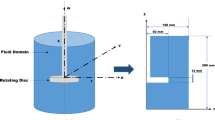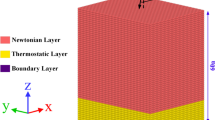Abstract
Advancements in nanoscale precision engineering require an in-depth understanding of energy transport. The thermal properties of fluids containing nano-particles significantly depend on the particle/fluid volume ratio at high interface thermal resistance lengths (Kapitza lengths). However, there is a lack of fundamental understanding of nano-scale thermal transport based on the continuum mechanics. In nano-scale thermal transport, the molecular structure of the liquid and surfaces and their interactions on atomic length scales are indispensable. In this study, a molecular level investigation of the thermal resistance at the silicon-argon interface is implemented using molecular dynamics (MD) simulations. This research investigates the interface thermal resistance between liquid argon and silicon surfaces with a perfect crystalline structure. Silicon and argon are chosen due to their broad use in nano-technology applications. Layering of argon liquid molecules on the silicon solid interface was evident for weak wall/fluid interaction strength and bin sizes smaller than the molecular diameter. A recently developed interface thermal resistance (Kapitza resistance) model is used in this study (Kim et al., Journal of Chemical Physics, 129, 174701, 2008). Interactive thermal wall (ITW) model can significantly reduce the computational cost for silicon crystal walls. However, the ITW model needs to properly model thermal interactions with argon molecules using modified liquid/solid interaction strength and thermal oscillation frequency. Our simulation result matches with the case for the ITW model for the similar liquid/solid interaction strength.
Similar content being viewed by others
Abbreviations
- a :
-
Lattice constant (nm)
- N :
-
Number of molecules (liquid or solid)
- σ :
-
Diameter of molecules (zero potential distance) (nm)
- R K :
-
Kapitza resistance (interface thermal resistance)
- L K :
-
Kapitza length (nm)
- τ :
-
Time step (fs)
- ɛ :
-
Depth of Lennard-Jones potential wall (J)
- ω :
-
Thermal oscillation frequency
- λ :
-
Thermal conductivity (Wm2/K)
- ρ :
-
Number density (N/σ3)
References
Cahill, D. G., Ford, W. K., Goodson, K. E., Mahan, G. D., Majumdar, A., Maris, H. J., Merlin, R., and Phillpot, S. R., “Nanoscale Thermal Transport,” J. Appl. Phys., Vol. 93, pp. 793–818, 2003.
Karniadakis, G., Aluru, N. R., and Beskok, A., “Microflows and Nanoflows,” Springer, 2005.
Kim, B. H., Beskok, A., and Cagin, T., “Molecular Dynamics Simulations of Thermal Resistance at the Liquid-Solid Interface,” J. Chem. Phys., Vol. 129, No. 17, Paper No. 174701, 2008.
Kim, B., Beskok, A., and Cagin, T., “Viscous Heating in Nanoscale Shear Driven Liquid Flows,” Microfluidics and Nanofluidics, Vol. 9, pp. 31–40, 2010.
Heslot, F., Fraysse, N., and Cazabat, A. M., “Molecular Layering in the Spreading of Wetting Liquid Drops,” Nature, Vol. 338, pp. 640–642, 1989.
Barrat, J. and Chiaruttini, F., “Kapitza Resistance at the liquid&solid Interface,” Mol. Phys., Vol. 101, pp. 1605–1610, 2003.
Koplik, J., Banavar, J. R., and Willemsen, J. F., “Molecular Dynamics of Fluid Flow at Solid Surfaces,” Phys. Fluids A, Vol. 1, pp. 781–794, 1989.
Li, Y., Xu, J., and Li, D., “Molecular Dynamics Simulation of Nanoscale Liquid Flows,” Microfluidics and Nanofluidics, Vol. 9, pp. 1011–1031, 2010.
Allen, M. P. and Tildesley, D. J., “In Computer simulation of liquids,” Oxford, 1989.
Pollack, G. L., “Kapitza Resistance,” Rev. Mod. Phys., Vol. 41, pp. 48–81, 1969.
Stillinger, F. H. and Weber, T. A., “Computer Simulation of Local Order in Condensed Phases of Silicon,” Phys. Rev. B, Vol. 31, pp. 5262–5271, 1985.
Luedtke, W. D. and Landman, U., “Preparation, Structure, Dynamics, and Energetics of Amorphous Silicon: A Molecular-Dynamics Study,” Phys. Rev. B, Vol. 40, pp. 1164–1174, 1989.
Chaudhuri, D., Chaudhuri, A., and Sengupta, S., “Heat Conduction through a Trapped Solid: The Effect of Structural Changes on the Thermal Conductance,” Journal of Physics: Condensed Matter, Vol. 19, pp. 152–201, 2007.
Chaudhuri, D. and Dhar, A., “Heat Conduction in a Confined Solid Strip: Response to External Strain,” Phys. Rev. E., Vol. 74, Paper No. 016114, 2006.
Semiromi, D. and Azimian, A., “Molecular Dynamics Simulation of Annular Flow Boiling with the Modified Lennard-Jones Potential Function,” Heat and Mass Transfer, Vol. 48, pp. 141–152, 2012.
Xue, L., Keblinski, P., Phillpot, S. R., Choi, S. U., and Eastman, J. A., “Effect of Liquid Layering at the liquid-solid Interface on Thermal Transport,” Int. J. Heat Mass Transfer, Vol. 47, pp. 4277–4284, 2004.
Swartz, E. T. and Pohl, R. O., “Thermal Boundary Resistance,” Rev. Mod. Phys., Vol. 61, pp. 605–668, 1989.
Xue, L., Keblinski, P., Phillpot, S. R., Choi, S. U., and Eastman, J. A., “Two Regimes of Thermal Resistance at a Liquid—Solid Interface,” J. Chem. Phys., Vol. 118, pp. 337–339, 2003.
Stevens, R. J., Zhigilei, L. V., and Norris, P. M., “Effects of Temperature and Disorder on Thermal Boundary Conductance at solid-solid Interfaces: Nonequilibrium Molecular Dynamics Simulations,” Int. J. Heat Mass Transfer, Vol. 50, pp. 3977–3989, 2007.
Prasher, R. S. and Phelan, P. E., “A Scattering-Mediated Acoustic Mismatch Model for the Prediction of Thermal Boundary Resistance,” J. Heat Transfer, Vol. 123, pp. 105–112, 2001.
Torii, D., Ohara, T., and Ishida, K., “Molecular-Scale Mechanism of Thermal Resistance at the Solid-Liquid Interfaces: Influence of Interaction Parameters between Solid and Liquid Molecules,” J. Heat Transfer, Vol. 132, Paper No. 012402, 2010.
Sofos, F., Karakasidis, T., and Liakopoulos, A., “Transport Properties of Liquid Argon in Krypton Nanochannels: Anisotropy and Non-Homogeneity Introduced by the Solid Walls,” Int. J. Heat Mass Transfer, Vol. 52, pp. 735–743, 2009.
Sun, J., He, Y., Tao, W., Yin, X., and Wang, H., “Roughness Effect on Flow and Thermal Boundaries in microchannel/nanochannel Flow using Molecular Dynamics-Continuum Hybrid Simulation,” Int. J. Numer Methods Eng., Vol. 89, pp. 2–19, 2012.
Kalweit, M. and Drikakis, D., “Multiscale Methods for Micro/Nano Flows and Materials,” Journal of Computational and Theoretical Nanoscience, Vol. 5, pp.1923–1938, 2008.
Shi, Z., Barisik, M., and Beskok, A., “Molecular Dynamics Modeling of Thermal Resistance at Argon-Graphite and Argon-Silver Interfaces,” International Journal of Thermal Sciences, Vol. 59, pp. 29–37, 2012.
Sidpara, A. and Jain, V., “Experimental investigations into surface roughness and yield stress in magnetorheological fluid based nano-finishing process,” Int. J. Precis. Eng. Manuf., Vol. 13, pp. 855–860, 2012.
Author information
Authors and Affiliations
Corresponding author
Rights and permissions
About this article
Cite this article
Kim, B. Interface thermal resistance modeling of the silicon-argon interface. Int. J. Precis. Eng. Manuf. 14, 1023–1028 (2013). https://doi.org/10.1007/s12541-013-0137-4
Received:
Accepted:
Published:
Issue Date:
DOI: https://doi.org/10.1007/s12541-013-0137-4




